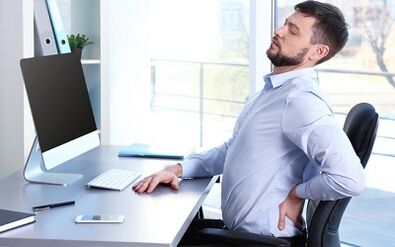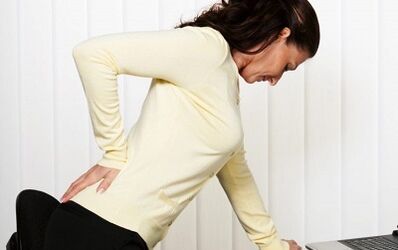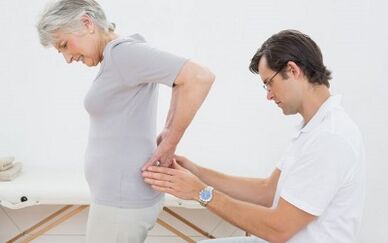
Acute pain in the lumbar region, against the background of the osteocondrosis of the spine, is a widespread problem that the vast majority of people face.Coming to us "as a reward" for our simplicity (due to the increase in the axial load on the spinal column), this disorder sooner or later affects each resident of the planet, the only question is what quickly happens and what the symptoms have expressed.These "slender" statistics force this pathology to socially significant diseases and the fight against it should be the task not only a person who suffers from manifestations of the disease, but also of the world health system as a whole.Therefore, the problem of the treatment of the osteocondrosis of the spine is a very relevant topic.
So what is osteochondrosis?Briefly consider how the development of the disease occurs.In its own name, if you translate it from Latin literally, the structures that change with osteochondrosis are determined: bone and cartilage.In order to depict and resist the vertical loads, the nature placed among our vertebrae is a peculiar "cushions" discs of "cushions".Their diet is carried out during childhood due to the blood vessels, which are lost by about 25 years and nutrition begins to be widely due to the surrounding muscles.
In the pathological loads on the spine (sedentary work or vice versa - excessive physical activity), violations of the processes of the mineral metabolism, the intervertebral disc loses its elastic and shock absorbing properties, its height decreases, the structure of the vertebrae changes, the pathological bone growth (ostefite and the dressing plate) have changed mobility.The affected area of the spine.In the late phases of the disease, the central part of the intervertebral disc, the nucleus of the jacket thus called, which breaks through the fibrous ring, forms a sort of protrusion bag between the bodies of the vertebrae - the intervertebral hernia.A hernia can cause compression of the nerve roots adjacent to the vertebrae, an intense pain in the compression area occurs, as well as in the area regulated by the nerve concerned.Due to the constant irritation of the nervous plexus, a spasm reflection of the skeletal muscles occurs, called the protective defense in medicine, which on the one hand protects the suffering section of the spine from excessive movements and, on the other, improves compression, edema and pain in the affected area.
In the vast majority of cases (90%) pain with osteochondrosis (even extremely pronounced) is due to muscle spasm!In other cases, the cause of pain is the compression of the nervous root or spinal cord directly from the hernia of the intervertebral disc.
Lumbar column osteochondrosis: how to treat
There are five parts of all parts of the spine, and in total (cervical, chest, lumbar, sacral and coccygeal), due to the maximum motor load, the lumbar often suffers from the manifestations of the disease.The osteochondrosis of the lumbar column has bright symptoms familiar to everyone, and its treatment is a significant social task, since the quality of life not only of the elderly worsens, but also the people active in working age.
The pain can be located directly in the lumbar region, as well as on the front surface of the thigh or along the entire rear or external surface of the leg, sometimes until the same fingers.Often, pain is given to the gluteal region, the sacred, the horse and sometimes they can only be located in these areas, masked by diseases of the sphere and parental intestine and making it difficult to produce the correct diagnosis.The intensity of pain syndrome can be so high that a person loses the ability to make the most elementary movements, takes forced poses and loses normal sleep.This is only the same Radicolite, which in size has long become synonymous with the disease itself.

Limitation of motor activity.The usual movements and sensitivity in the limbs are violated, muscle convulsions, paresthesia (sensations of tingling, burning "ghrching leather moans") occur).
Violation of the function of the pelvic organs.With intense root syndrome, known to all as radicolitis, or with enormous protrusion hernia, urination and intestinal work can even be disturbed, causing serious torments in the patient.
The treatment of the osteocondrosis of the lumbar column often becomes a difficult task for both the patient and the doctor.Every person who suffers from this disorder was asked by questions: "How to treat osteochondrosis of the lower back?", "How to treat osteochondrosis of the lumbar region?", "If the treatment of osteochondosis of the lumbar at home does not help - which doctor?", "If tablets and gold with osteochondosis - how to help?".
The following doctors will help to cope with the exacerbation of the osteocondrosis and prescribe a competent treatment: therapist, neurologist, medical massage specialist, manual therapist, physiotherapist and, if necessary, surgical treatment is a neurosurgery.
Ways to combat osteochondosis of the lumbar column
The main thing in the treatment of osteocondrosis is the right lifestyle!In people who are actively and correctly involved in physical culture and monitor the spine, the back never hurts!Unfortunately, few people follow these simple truths.
By analyzing this problem, you can highlight:
- drug;
- Not a drug.
Non -pharmacological methods for the treatment of lumbar column pathology
- Distraction procedures.Their effect lies in the name itself: the use of various applicators, rugs and rollers of massages, wool belts, "lotions" and "rubbing" due to the effects on surface nerve endings and on blood vessels slightly reduces muscle spasm and pain syndrome.These methods can be used as auxiliary, but isolated use is ineffective for the exacerbation of osteochondosis of the lumbar region without systemic treatment with special drugs.
- Immobilization means.These vehicles are understood as bandages of various design, whose spine protects the spine from sudden and "dangerous" movements and redistribute the load during static work.The real estate means can be purchased in medical equipment stores and pharmacies, however, before buying it, it is advisable to consult a doctor who will help determine the design, rigidity and optimal completion of the bandage in your situation.It is recommended to use them only for the time of exposure to adverse factors (travel for wheel, seated work and so on), since prolonged use causes muscle hypotrophy.
- Medical physical education (exercise therapy)- an full component of the complex -obstenocondrosis treatment.The execution of exercises aimed at maintaining the tone of the muscles of the back of the back and removing the spasm of the pathological muscles helps to restore and maintain motor activity, reduce the intensity of pain syndrome.A significant advantage of operating therapy is that after training by the instructor, a person can independently perform exercises at home daily, as well as in the existence of a series of exercises applicable also with an exacerbation of the process.The most effective method for exercise therapy is meccanotherapy - classes on simulators according to a method developed individually, since the formation of muscle corset needs to work with weights.
- Massage- A well -known from ancient times, the most common way and, perhaps, the most common way of prevention and treatment, however, cannot be used in the phase of exacerbation of the osteochondosis of the lumbar.In addition, only a specialist with a medical education, who knows anatomy and physiology and techniques of possession of medical massage, should carry out a massage with osteochondrosis.
- Manual therapyAnd in recent years, osteopathy in recent years performed by a competent professional can have a significant healing effect and even eliminate the exacerbations of the disease for a long time.It is also important to remember that when it turns to a manual therapist before the start of the procedures, it is necessary to conduct an examination of the vertebral column tool (X -ray, imaging of calculated or magnetic resonance, osteodensitometry) to allow the doctor to evaluate the prevalence and severity of the process and exclude possible contraindications for manipulation.Like massage, manual therapy and osteopathy have a series of contraindications, for example a pronounced compression of the nerve root of hernias, subluxation of the vertebrae.In the acute period of osteochondosis of the lumbar region, usually soft techniques of manual therapy (muscle relaxation and so on) are used.
- Acupuncture.Based on the results of recent studies, the use of this method of popular methodology in large circles is considered medicine based on unreasonable evidence for osteochondosis of the lumbar column that does not eliminate the symptoms of the disease and refers to non -traditional treatment methods.
- Physiotherapy, included in national clinical recommendations and in the standards for the supply of medical treatment for osteochondrosis, has long demonstrated its effectiveness in the treatment of this disease.With osteochondrosis of the lumbar column, electromystimulation, amplipulse therapy, shock wave therapy, intimate myostimulation, laser therapy.Magnetotherapy remains the popular method in the complex treatment.Its advantages include a good tolerance and a small list of contraindications, the possibility of use in the acute period of the disease.By acting on all connections of the pathological process, after several procedures it significantly reduces pain and allows a person to expand motor activity.In addition, improving the trophism of the affected tissues, slows down the progression of the disease.An unconditional advantage of this method is the possibility of its independent use by the patient outside the walls of a medical institution.
But if all the non -drug methods above were ineffective, how to treat lumbar osteochondosis?
Pharmacological treatment
Diseases involve the appointment of the following medicinal groups.
Non -pounded anti -inflammatory drugs (NSAIDs) are produced in shapes for rooms (gel, ointments, cream) and for systemic use (tablets, candles, solutions for intramuscular and intravenous administration).Their action is based on the blocking of the inflammatory process at an enzymatic level, following which edema is eliminated in the injury area and pain syndrome is significantly reduced.
In the early stages of the disease, there are quite local use of fans in combination with non -valley methods (therapeutic exercises, magnetotherapy).With a pronounced pathological process and an intense pain syndrome, it is necessary to resort to tablet and sometimes injectable forms of drugs.
Unfortunately, to have a good anti-inflammatory and analgesic effect of the NSAIDs, with prolonged systemic use, the development and exacerbation of the erosive-Ulceosis processes of the gastrointestinal tract, as well as an altered renal and liver function.Therefore, patients taking fans need drugs that protect the gastric mucosa and regular laboratory control of the liver and kidneys.
Systemic muscle relaxants, that is, drugs that relieve muscle spasm.The principle of their action lies in the title: relaxation of the spasmodic muscles helps to reduce the compression of nerves and blood vessels, edema in the damage area: blood circulation and innervation improves - pain decreases;Due to the decrease in muscle defense, the tension of the binding apparatus decreases: the stabbing (protrusion) of the intervertebral disc decreases - the pain attenuates, the volume of the movements increases.
Musroxants for the treatment of osteochondosis of the spine are produced in the form of tablets and solutions for intramuscular administration, to achieve the therapeutic effect, must be taken for a long time, gradually increasing the dose.Just like fans, muscle relaxants have a series of contraindications and can cause unwanted side effects, therefore, despite the free sale in pharmacy networks, before buying them, it is necessary to consult a doctor.

Local anesthetics or drugs for local anesthesia are used for the pharmacological treatment of lumbar osteocondrosis in the form of the paravertebral block thus called, when the pharmacological solution is administered first subcutaneous, and therefore in the area of the vertebral processes affected in the projection of the alleged compression of the root n.
When it accumulates in the membranes of nerve fibers, the drug effectively blocks the pain signal.The therapist will certainly not be able to perform such a block;For its conduct, you need to contact a neurologist or neurosurgeon.
In addition, glucocorticosteroid solutions (GKS) - hormonal drugs with an anti -inflammatory effect pronounced are sometimes used for paravertebral administration.Their local application allows to obtain maximum effect when minimizing the risk of unwanted side effects of the drug.This block is carried out courses 2-3 times a year, a neurologist or a neurosurgery doctor should perform them.
Vitamins B "B".In any pharmacy you can find a variety of drugs of this group, both in the forms for oral administration and for intramuscular administration.They are believed that they have a neurotrophic and mild analogizing effect, however, a reliable justification for their use for osteochondosis of the spine has not been obtained through medicine based on evidence.
Physiotherapy for osteochondosis of the lumbar
Unfortunately, sometimes a complete treatment with modern medicines, physiotherapy, massage and exercise is ineffective: a person continues to feel pain, remains the limitation of physical activity and the quality of life suffers significantly.This happens in the subsequent stages of the disease, when volumetric hernias are formed, often multiple of intervertebral discs.In this situation, surgical treatment is shown.In addition, surgery is indicated with the "decay of an hernia" called this, when a significant compression of the spinal canal causes non -scanned pain, sterodynamic disorders and blocking of the function of the bladder and intestine.In such cases, the operation is performed on an emergency order.The purpose of surgical interventions for osteochondosis of the lumbar column is the mechanical decompression of the spinal canal and the nerve roots.
Currently, both long -standing volumetric surgical methods are used in the surgical treatment of osteocondrosis and in the minimally invasive endoscopic interventions proposed by modern medicine using laser effects and radio frequencies, some of which can also be performed under relief from local pain.
Having examined the main methods for the treatment of osteochondosis of the lumbar column, I would once again see that the patient who ascended the question "How to cure lumbar osteochondrosis?"?He should rely not only for the help of doctors, but also for his own forces, including the meaning of a healthy lifestyle, in which adequate and mainly dosed physical activity is present and, above all, there is a branch of in. Victory over the disease.















































